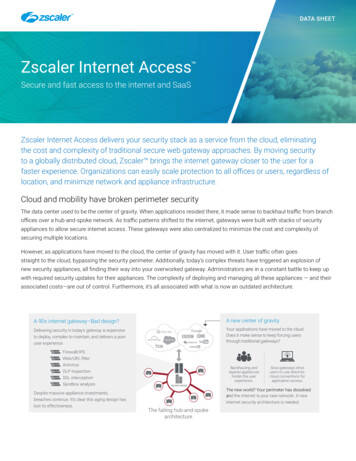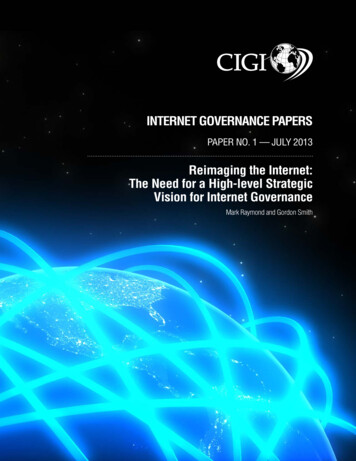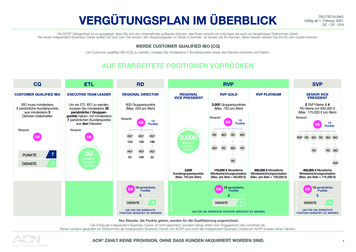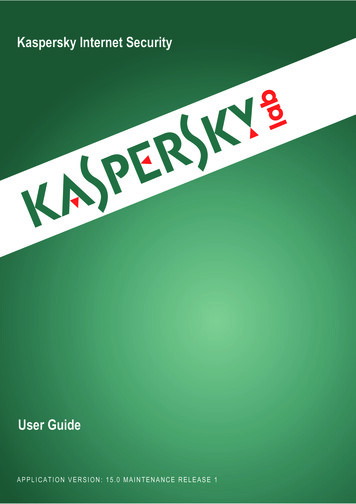
Transcription
CANADIANS DESERVEA BETTER INTERNET06-02-2019
TA B L E O F C O N T E N T S2Foreward3Key findings in this report6I. Trust in content:Countering fake news online8II. Privacy15III. Cybersecurity22IV. Access26V. Internet governance30Conclusion and recommendations34About CIRA and this report37
FOREWORDBY BY R O N H O L L A N D, P R E S I D E N T A N D C E OThe internet has revolutionized the day-to-day lives of Canadians in how we communicate, work,shop and access services. This global resource connects us all, but it is not administered in ahomogenous way around the world. Diverging ideologies have created an internet with starkdifferences from region to region, and contrasting philosophies within those regions.There are the democracies of the West with an open, industry-driven internet versus moreauthoritarian states, with a command-and-control approach. Within each are variations. Someautocracies have more or less control, all the way up to the extremes of China and its Great Firewall.In the West, there is a contrast between the privacy regulations of Europe and the data-drivenCalifornian internet, which is largely the internet Canadians experience.The impacts of these global discrepancies, as well as activity taking place closer to home, affect thesafety and security of Canadians online today, and the future of the internet as we know it.In the age of fake news and election interference, Canadians are unsettled by the viral spread ofmisinformation on their social media channels. Most of the free online services Canadians have cometo enjoy have a cost – our personal information. Demographic and psychographic profiles of ouronline activities are immensely valuable. Canadians’ personal data powers the ad networks to nudgeusers toward specific purchases and algorithms driven by users’ online activity serve up targetedonline content.While this digital advertising machine may mean more convenience for some Canadians, and in spiteof users’ affinity for these free platforms and online services, Canadians are concerned about howcompanies collect and use their personal information1. After all, it’s rare that a week goes by withouta cyberattack or security vulnerability making headlines.31Findings from CIRA’s research, December 2018/January 2019, refer to the privacy section of thisreport.
Even with all of that, the internet in Canada is a powerful force for good—enabling access toknowledge, underpinning commerce and connecting us to communities of interest at home andabroad. The majority of Canadians now have internet access. Notwithstanding inequities in thequality of that access, the internet is, for the most part, ubiquitous in the lives of average Canadians.Yet, the open internet envisioned by the early luminaries of networking and the World Wide Web isbeing challenged on a number of fronts: misinformation, privacy, security, access and governance.The internet was designed to be open and interoperable. The architecture allows anyone witha modem to connect her or his host to the network. This utopian vision for collaboration andcommunity has resulted in an architecture that is inherently vulnerable to malicious players seekingto ruin everyone else’s fun. The openness of the internet is both its strength and its weakness.While internet governance has primarily focused on protocols of the internet, today’s governancemust carefully account for increasing malicious activity on the internet. At the content level, there isa proliferation of fake news, hate speech and invasions of personal privacy. At the infrastructure andprotocol levels, large-scale attacks have become commonplace.The only way to meaningfully address these complex, supranational issues is through engagementbetween governments, civil society and the private sector about internet governance. This is newterritory for everyone involved, but it’s also an opportunity for citizens to demand the internet theywant and deserve from industry and policy-makers.As the steward of the .CA domain on behalf of all Canadians, and as an active participant of internetgovernance, CIRA seeks greater understanding of the issues, and solutions for a better onlineCanada. In December 2018, CIRA surveyed Canadians to learn more about their opinions andexperiences online. The following report breaks down these experiences and what Canadians want4
for Canada’s internet. Unfortunately, the concerns are many. However, so too are possible solutions.Based on CIRA’s research, Canadians see three key players: government, business and citizensthemselves.As internet advocates, stewards, policy-makers and experts gather for the 2019 Canadian InternetGovernance Forum, we must listen to Canadians and work together to meet their demands. Theydeserve our full attention and action on a resource so central to most Canadians’ everyday lives.Ultimately, Canadians deserve a better internet – and it’s up to all of us to provide it.5
KEY FINDINGS IN THIS REPORTOf Canadian internet users:S O C I A L M E D I A A N D FA K E N E W S 75% say they come across fake news at least sometimes. 57% have been taken in by a fake news item. 70% are concerned that fake news could impact the outcome of the next federal election.P R I VA C Y 72% are willing to disclose some or a little personal information in exchange for a valuable/convenient service. 87% are concerned that businesses with access to customers’ personal data willingly share itwith third parties without consent. 86% believe it is important that government data, including the personal information ofCanadians, be stored and transmitted in Canada only.CYBERSECURITY 87% are concerned about a potential cyberattack against organizations with access to theirpersonal data. Only 19% say they would continue to do business with an organization if their personal datawere exposed in a cyberattack. 678% are concerned about the potential security threats related to the Internet of Things.
ACCESS 69% believe the high cost of internet services, including for mobile data, is hurting Canada’seconomy and prosperity. 83% believe that universal access to high-speed internet is important for Canada’s overalleconomic growth and prosperity. 70% agree that the Canadian government should be doing more to support public access tohigh-speed internet.INTERNET GOVERNANCE 75% say they only know a little or hardly anything about the topic of global control andregulation of the internet. 50% are concerned that the global internet could fracture into regional blocks that adopt verydifferent regulatory principles and policies. 766% support the principles of net neutrality.
I.TRUST IN CONTENT:COUNTERING FAKE NEWS ONLINEIn the early days of the internet, when everyday citizens began accessing websites and email, onlinecontent was new, exciting and interesting. But, what online content wasn’t, was trusted.Anyone who went to university in the late 1990s or early 2000s will remember that universities rarelyaccepted online sources as these had not gone through the fact-checking of a peer review. Studentsof the time relied on tried and true methods of research, primarily found in a library. The online worldwas new and most people were not yet comfortable with its content.Fast forward 20 years, and online content permeates the schools, workplaces and living rooms ofnearly all Canadians. Readership of trusted sources of the past including newspapers, which havetheir own journalistic standards, are on the decline as eyeballs turn to the internet. In fact, academicresearch papers, respected newspapers and magazines, and many other sources of news andinformation are now accessed easily online alongside content without the same stringent editorialreview processes.According to Canada’s Internet Factbook 20182, 55 per cent of Canadian internet users access newsand current events via the internet. Whether via subscription or otherwise, Canadians now get theirnews online.When thinking about the pervasiveness of online content and news – in sharing it and accessing it –one cannot ignore the rising concern among Canadians about fake news, or fabricated news storiesthat grossly misrepresent actual events. On this front, three quarters of Canadian internet users saythey at least sometimes encounter fake news online, and the majority agree that it’s a problem.28Canada’s Internet Factbook, 2018, internetfactbook.ca
Percentage of respondentsthat agree the spreadof fake news on social mediaYESNOis a problemUNSURE87%9%4%Questions around the influence of fake news on the 2016 U.S. presidential election highlight thegrowing need to analyze the power and prevalence of fake news. Fake news takes many forms, andcan include wholly inaccurate content, news that misrepresents facts or is biased, and old storiespassing as current news. It can also include echo chambers, whereby social media sites serve usersimbalanced content, largely through algorithms based on their past online behavior, confirming andsupporting views the user already holds or leans toward.The lessons learned south of the border have encouraged 70 per cent of Canadian’s surveyed toexpress concern that fake news could impact the outcome of the next Canadian federal election. Theurgency in this case is clear.Level of concern that fakenews could impact the nextCanadian federal electionCONCERNEDNOTCONCERNEDUNSURE/NEUTRAL970 %14 %16 %
S O C I A L M E D I A A N D S P R E A D I N G M I S I N F O R M AT I O N O N L I N EWhere does fake news flourish and how is it spread? To many, the answer lies in social mediaplatforms.CIRA’s research indicates that 80 per cent of social media users read or listen to news items sharedby others and about a third share news items with others via social media. Given that nearly 70 percent of internet users in Canada say they access a social media site almost every day, this is worthreflection.Consider as well that while eight in ten Canadians are confident in their ability to recognize fakenews stories online, just one quarter are very confident. Of greater concern, over half of Canadiansadmit they’ve been taken in by a fake news item.Percentage of respondentsYESwho believed what they laterfound out to be fake newsNOUNSURE57%34 %9%S T O P P I N G T H E S P R E A D O F FA K E N E W S :T H E R O L E O F G O V E R N M E N T, S O C I A L M E D I A C O M P A N I E SAND THE MEDIAIf you ask Canadian internet users, they see the responsibility to stop the spread of fake news splitbetween social media companies, the press, the federal government and citizens themselves.10
72 %SOCIAL MEDIA COMPANIESResponsibility to stop thespread of fake news68 %67 %MEDIA/PRESS/BROADCASTERSCITIZENS THEMSELVES63 %JOURNALISTS50 %FEDERAL GOVERNMENT8%OTHER/DON’T KNOWWhen asked which of these should have the responsibility in monitoring and removing fake newsfrom their platform, 91 per cent say social media should have at least some responsibility and nearlyhalf of Canadians say these companies should have complete responsibility.Social media companies, including Facebook, have begun to react. In April, 2018, Facebookpublished a blog3 outlining the “70 Facebook and 65 Instagram accounts – as well as 138 FacebookPages – that were controlled by the Russia-based Internet Research Agency,” that were removed tocounteract the spread of fake news on their platform.At the DLD conference in January 2019, Facebook COO Sheryl Sandberg shared five things Facebookwould do in 20194 to counter fake news. Two questions remain though. Is this action enough?Moreover, is it too little too late?3411Authenticity Matters: The IRA Has No Place on Facebook matters/Stung by criticism, Facebook’s Sandberg outlines new plans to tackle plans-to-tackle-misinformation/
A majority (79 per cent) of Canadians want the federal government to impose fines or other sanctionson social media companies that do not act to remove fake news from their platforms. To date,the Canadian government has not taken such drastic action. In advance of the upcoming federalelection, the Government of Canada has announced a five-member panel of senior bureaucrats thatwill analyze threats and inform political parties and the public of those threats.5With or without government intervention, social media companies have a responsibility to stopthe spread of fake news. However, given the speed with which news travels online, social mediacompanies cannot stop fake news alone. In addition to the government and social media companies,Canadians also see traditional media and journalists as catalysts to stop misinformation fromspreading online.While most Canadians are at least somewhat confident that the information they access throughmajor newspapers, TV news networks and radio stations in Canada is generally fair and accurate, fewsay the same of video hosting websites, podcasts and social media/messaging apps.81 %MAJOR NEWSPAPERS (PRINTED/ONLINE)Confidence that news/information is generally fairand accurate80 %78 %TV NEWS NETWORKSRADIO STATIONS27 %VIDEO HOSTING WEBSITES AND PODCASTS21 %ONLINE SOCIAL MEDIA SITES AND MESSAGING APPS512Federal plan to protect elections does not include controls on social-media platforms, Globe & Mail, January 30, lude-controls-on-social/
Given that trust exists in more traditional media sources, Canadian journalists can help thwart fakenews online. Whether through fact-checking or countering false information spreading online,journalists are in a position to make a positive impact. However, with a shrinking traditional medialandscape whereby roughly one-third of journalism jobs have been lost in the past six years6, howlong can Canadians rely on this valuable source of information?INDIVIDUAL CANADIANS CAN STOPT H E I N F L U E N C E O F FA K E N E W SWhat are the responsibilities of citizens themselves? Canadians are alert to the possibility of fakenews online, but how can they be sure when they encounter it?Digital and media literacy are important for all Canadians to better navigate the online world – andCanadian internet users agree.75 %agree that Canada’s public schools should placemore of a focus on digital literacy for students.83 %agree that Canada’s public schools should placemore of a focus on media literacy for students.Canada is investing in digital literacy. For example, the federal CanCode program invested over 50million to support initiatives providing educational opportunities for coding and digital skills forCanadian youth from kindergarten to grade 12 7.6Canadian news industry at crisis point, suggests new report, CBC, at-crisis-point-suggests-new-report-1.3953678 with full report: hatteredMirror.pdf137CanCode, from Innovation, Science and Economic Development Canada, https://www.ic.gc.ca/eic/site/121.nsf/eng/home
As well, the Canadian government announced 7 million in funding this past January to fight thespread of fake news online. The funding will be split between organizations conducting digitalliteracy programs to help voters better assess online information and groups working to increaseunderstanding of disinformation8.Both Facebook and Google are also funding similar support initiatives, with Google giving 500,000to the Canadian Journalism Foundation and Civix to teach students to recognize fake news online9.Facebook has also launched a “digital news literacy campaign” with the digital and media literacyorganization MediaSmarts10.Organizations like CIRA are investing in this important value-add as well. Like Facebook, CIRAsupports MediaSmarts. CIRA recently provided over 80,000 to MediaSmarts to carry out qualitativeresearch for Phase IV of Young Canadians in the Wired World11, which tracks and investigates thebehaviours, attitudes and opinions of Canadian children and youth with respect to their use of theinternet. This research will provide the foundation and direction for the quantitative classroom-basedresearch instruments for a national survey to follow. Considering how many Canadian adults havebeen taken in by fake news, arming children with media literacy skills early on is important.With only a quarter of Canadians fully confident they can recognize fake news online, theseinvestments – both time and money – are much needed.8Federal government to announce 7 million in funding to fight disinformation online ahead of 2019 election, The Logic, January29, 2018, nformationonline-ahead-of-2019-election/?gift 90e7f4480bfff7a20e89a0ca384cc3d99Google bankrolls Canadian school program targeting fake news, The Star, September 19, fake-news.html10Facebook launches ‘election integrity initiative’ to fight hacking and fake news, CBC, October 19, ction-hacking-fake-news-1.43620021411Young Canadians in a Wired World, Phase III: Life Online, MediaSmarts, http://mediasmarts.ca/ycww/life-online
II.PRIVACYCanadians value their privacy. In fact, six in ten Canadian internet users say they value it overconvenience with only seven per cent saying convenience was more important to them than privacy.7%CONVENIENCEWhich is more important –convenience or privacy?63 %23 %PRIVACYDEPENDS ON THE SITUATION6%IT’S TOO HARD TO CHOOSE1%UNSUREHowever, while Canadians value it and say they want it, they make choices online that put theirprivacy at risk.For example, many Canadians visit a social media site every day. These sites, along with manywebsites, are free to use, where the cost of admission is the user’s information. This feeds advertisersthe data to target users and serve them ads. In fact, many Canadians say they are willing to disclosesome personal information in exchange for a valuable or convenient service.72 %Are willing to disclose ‘some’ or ‘a little’private/personal information for a valuable orconvenient service15
This willingness decreases with age whereby 18-49 year olds are more willing to give up a ‘greatdeal’ or ‘some’ private information versus those over 50.50Willingness to give up a greatinformation for a valuable40PERCENTAGEdeal/some private or personal45%4532%35302522%18%2015or convenient service105018-3435-4950-6465 AGES80they value privacy overconvenience72%60PERCENTAGEPeople who indicate70%66%705048%40302010018-3435-4950-6465 AGESAt the same time, nine in ten Canadians are concerned that businesses with access to personal datawillingly share it with third parties without consent and over half of Canadian internet users saythey are willing to share personal information in exchange for better programs and services fromthe government. On this note as well, nearly half (42 per cent) support sharing Canadians’ personalinformation with law enforcement agencies, with some restrictions. Though, seven per cent supportthis with no restrictions.16
C A N A D I A N D ATA T R AV E L I N G S O U T H O F T H E B O R D E RWhile most Canadian internet users (78 per cent) are concerned about the security and privacy oftheir personal information if stored in or routed through the United States, only half of Canadians areaware that many cloud services in Canada store data on servers located in the U.S. Even fewer areaware that some communications intended to begin and end in Canada run through the U.S.Awareness that someof Canada’s internetinfrastructure runs throughYESNOthe U.S.UNSURE47 %44 %9%Even worse, 79 per cent of Canadian internet users say, if given a choice, they would prefer to usecloud services whose servers are located in Canada (and thus regulated under Canadian privacylaws). However, a mere eight per cent of cloud service users have ever switched to one based inCanada. Canadians appear to understand the risk, but fail to act against it.Incidence of switching cloudYESservices to use one whoseservers are located in CanadaNOUNSURE178%81 %11 %
Canadians want to have their cake, and eat it too. They want more privacy, but they also wantgreater convenience. They want businesses, their government and law enforcement to accessprivate information in order to provide better services, but they remain concerned with whathappens to their personal information. How can Canadians have the convenience they desire, whileremaining secure in the knowledge that their privacy is protected online?E N H A N C I N G P R I VA C Y P R O T E C T I O NOne solution could be tapping into the willingness of some Canadians to pay more for onlineservices. Currently, the currency online is personal data. Data has recently been dubbed the newoil, indicating the value of this resource.12 Given that six in ten Canadians say they would pay morefor products and services that guarantee protection of privacy and personal data, this could be anoption for some Canadian businesses. However, it remains to be seen whether Canadians’ willingnesswould remain strong if presented with an actual dollar amount.Canadian businesses are taking action in other ways too. According to CIRA’s cybersecurity survey13,released in October 2018, the top reason Canadian businesses devote resources to cybersecuritymeasures is to protect the information of their customers.12The world’s most valuable resource is no longer oil, but data, The Economist, May -but-data1318Fall 2018, Cybersecurity survey, CIRA, https://cira.ca/2018-cybersecurity-survey-report
Despite this, more can and should be done. Canada has regulations in place around privacy. ThePersonal Information Protection and Electronic Documents Act (PIPEDA) is the Canadian federalprivacy law for private-sector organizations. While 59 per cent of small-to-medium sized businessesthat responded to the fall CIRA cybersecurity survey said they stored personal information fromcustomers, only 38 per cent said they were familiar with PIPEDA14.In November, significant changes were made to PIPEDA, impacting Canadian businesses of all sizes,including new mandatory breach reporting requirements. There are penalties, with fines up to 100,000 for non-compliance.Businesses need to understand the laws in place and must follow them.Another approach might be enhanced Privacy by Design methodology, developed by AnnCavoukian, the former Information and Privacy Commissioner for Ontario. This framework considers1419Fall 2018, Cybersecurity survey, CIRA, https://cira.ca/2018-cybersecurity-survey-report
privacy throughout the engineering process. However, this approach is imperfect and has been“criticized as being vague, difficult to enforce its adoption, difficult to apply to certain disciplines, aswell as prioritizing corporate interests over consumers’ interests and placing insufficient emphasison minimizing data collection”. 15 That said, the European General Data Protection Regulation (GDPR)incorporates Privacy by Design. Could there be aspects of this framework worth considering furtherin a Canadian context?CANADIAN INFRASTRUCTUREC A N E N H A N C E P R I VA C Y P R O T E C T I O NEight in ten Canadian internet users believe that government data, including the personalinformation of Canadians should be stored or transmitted in Canada only. Of those Canadians, overhalf believe this is critically important.Importance that governmentdata be stored/transmittedin Canada onlyIMPORTANTNOTIMPORTANTNEITHER/UNSURE152086 %3%11 %Privacy by design, Wikipedia, https://en.wikipedia.org/wiki/Privacy by design
Given that some Canadian data travels across the Canada-U.S. border, even data intended to staylocal, what is the Canadian government doing to ensure the private data of Canadians is protected?The Canadian government has an opportunity available to them right now to support greater privacyprotection of its citizens. Infrastructure investments, including investment into Canadian internetexchange points (IXPs), increase the chance that data intended to stay within Canada’s borders cando so.An IXP is a hub where those who peer at it can exchange data directly. This avoids the need totake the long route, which often results in exchanges occurring in the U.S. Once that data crossesthe border, Canadian privacy laws no longer apply. Given the Edward Snowden revelations of NSAsurveillance programs in the U.S., this should be of concern for all Canadians.With 11 IXPs up and running, Canada is doing well. However, these exchange points require a criticalmass of participation and currently, most large enterprises, governments and large internet serviceproviders are not using them. We need Canadian online entities to understand the value of CanadianIXPs and grow the number of organizations peering at them. One of the biggest impediments is thelack of peering by Canada’s largest internet service providers.Through greater participation and investment in Canadian IXPs, and other infrastructure such ascloud services and other hosting facilities that could be built in Canada, Canadian data meant to staylocal, can do so.21
III. CYBERSECURITYCybersecurity threats are a part of the online world. With reliance on digital technology growing,these threats are growing as well. Nearly 90 per cent of Canadian internet users are concerned aboutcyberattacks against organizations that access their personal data. Only two in ten say they wouldcontinue to do business with an organization if their personal data were exposed in a cyberattack,though our research does not show how many Canadians have actually actioned that sentiment.CONCERNEDRespondents concernedabout cyberattacksNOTCONCERNEDUNSURE/NEUTRAL87 %3%10 %This is a valid concern given that 40 per cent of businesses who responded to CIRA’s fallcybersecurity survey in 2018 admitted they had experienced a cyberattack in the last 12 months.Among larger businesses (250-499 employees) this number increases to 66 per cent. Overall, onein ten experienced more than 20 attacks16. Cybersecurity is a major issue and one that must beaddressed from all sides.1622Fall 2018, Cybersecurity survey, CIRA, https://cira.ca/2018-cybersecurity-survey-report
THE INTERNET OF THINGSNearly half of Canadians have at least one smart-home device. That includes items such as intelligentlight bulbs, smart thermostats or security devices such as Wi-Fi enabled cameras or internetconnected door locks. Eight in ten Canadian internet users are concerned about potential securitythreats related to IoT devices.Concern about potentialsecurity threats relatedto IoT devicesCONCERNEDNOTCONCERNEDUNSURE/NEUTRAL78 %3%19 %While Canadians’ concerns around IoT might be focused on personal security, where hackers canget into video camera feeds or take control of a door lock, CIRA’s Chief Technology Officer JacquesLatour sees the risks on a much larger scale. “Day-to-day use is not the biggest concern. It’s whenthere is a zero-day event that impacts a lot of devices all at once that I worry about.”Latour explains, “There is the good and bad of IoT devices. Some devices are well designed andsecure. Those are not of concern. But, there are devices out there that we need to watch out for.Many of these cheaper devices are less secure and use similar software applications as each other.That means that if those applications become compromised, that can turn into a large-scale attackaffecting hundreds or thousands of devices.”23
It’s at that point where IoT devices can be used to launch an attack on an online service or part ofthe larger internet. These types of attacks, called distributed denial-of-service attacks (DDoS), cantake down the internet, as the Mirai attack on Dyn did in 2016, affecting many websites and onlineservices including Netflix, Amazon, CNN, Shopify and VISA17.Latour represents CIRA in a multistakeholder process to identify and guide the development ofIoT policy in Canada, which includes the Government of Canada, the Internet Society, CIPPIC andCANARIE. Latour is also working on a CIRA secure home gateway that can help secure smarthome, IoT devices on a user-friendly platform to keep Canadians safe from attacks coming from theinternet, and the internet safe from compromised IoT devices.As the organization that manages the .CA domain on behalf of all Canadians, ensuring CIRA’s serversand the .CA domain registry is secure, is a top priority. Insecure IoT devices pose a clear risk to CIRA,the entire .CA space, as well as others who operate an internet business.INVESTING IN CYBERSECURITYMost Canadian internet users (82 per cent) believe the government should regulate how datacollected through smart-home devices is used and protected. Additionally, 77 per cent believe thegovernment should provide resources and infrastructure to Canadian businesses to help protectthem from cyberattacks.Should the government provideYESresources/infrastructure toprotect businessesNOagainst cyberattacks?UNSURE172477 %17 %6%2016 Dyn cyberattack, Wikipedia, https://en.wikipedia.org/wiki/2016 Dyn cyberattack
The government could be investing more and Canadian businesses must prioritize cybersecurity.Nearly a third of businesses who responded to CIRA’s cybersecurity survey in the fall 2018 said theywould add cybersecurity staff in the next year, which is good news. However, given that 37 percent of those survey respondents did not have anti-malware protection installed and a shocking 71per cent did not have a formal patching policy – additional investments in cybersecurity are muchneeded18.But it doesn’t stop w
6 KEY FINDINGS IN THIS REPORT Of Canadian internet users: SOCIAL MEDIA AND FAKE NEWS 75% say they come across fake news at least sometimes. 57% have been taken in by a fake news item. 70% are concerned that fake news could impact the outcome of the next federal election. PRIVACY 72% are willing to disclose some or a little personal information in exchange for a valuable/











